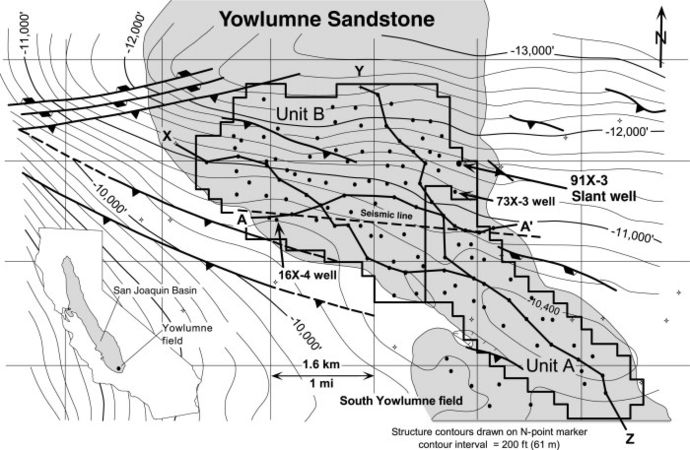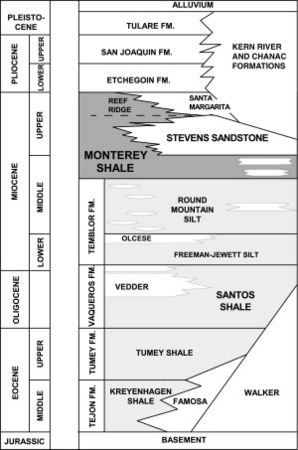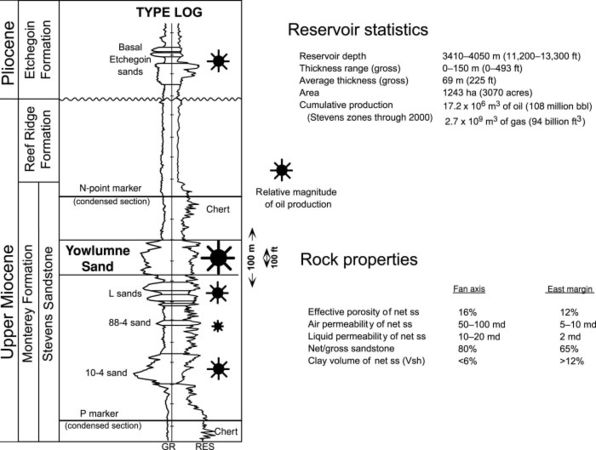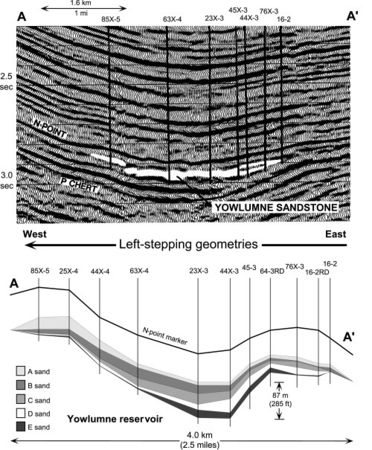Yowlumne field
| Horizontal Wells: Focus on the Reservoir | |
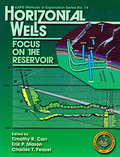
| |
| Series | Methods in Exploration No. 14 |
|---|---|
| Chapter | Characterization and exploitation of the distal margin of a fan-shaped turbidite reservoir: The ARCO-DOE 91X-3 horizontal well project, Yowlumne field, San Juaquin Basin, California |
| Author | Michael S. Clark, Rick K. Prather, John D. Melvin |
| Link | Web page |
| Store | AAPG Store |
Youlumne is a giant oil field in the San Joaquin Basin, California (Figure 1), that has produced, through December 2000, more than 17.2 million m3 (108 million bbl) of oil and 2.7 billion m3 (94 billion ft3) of gas from upper Miocene, deep-water sandstones known as the Stevens (Figure 1).
These sandstones, which represent classic facies of organic-rich shales in the Monterey Formation (Figure 2), are some of the most prolific reservoirs in the basin and have contributed about 15% of more than 1.9 billion m3 (12.3 billion bbl) of oil produced in the area since 1864. Because Stevens oils derive from Monterey Shale source rocks, Yowlumne is part of a Monterey-Stevens petroleum system (Graham and Williams).[1]
Most production at Yowlumne is from the Yowlumne Sandstone, one of several discontinuous sandstone bodies collectively referred to as the Stevens (Figure 3).
Structure[edit]
The oil accumulation at Yowlumne is controlled in part by an anticlinal closure formed during Miocene-Pliocene deformation of the south basin margin. Yowlumne Unit A was created to waterflood the area of structural closure, but subsequent drilling established production in a stratigraphic accumulation on the north-dipping flank of the anticline also (Figure 1). Consequently, Yowlumne Unit B was created to flood the flank accumulation (Burzlaff,[2] Metz and Whitworth[3]). Thus, the field is a combination structural-stratigraphic trap.
Flow units and reservoir compartments[edit]
More than 95% of production at Yowlumne field is from the Yowlumne Sandstone, a fan-shaped Stevens Sandstone body as much as 150 m (493 ft) thick (Figure 3). Bouma sequences evident in the cores from the field indicate deposition of this body by turbidity currents. Also, the Yowlumne Sandstune body is lens shaped in cross section and does not significantly incise underlying strata (Figure 4). Because large-scale channeling is absent, deposition was primarily as sheet sands transported by sediment-gravity flows.
Thin shales divide the fan into lobe-shaped reservoir layers (Figure 4). Five of these—the A, B, C, D, and E sands—produce oil from Unit B. The W sand is a basal sixth layer that is wet and isolated by pressure from over-lying sandstones. Layers A through E merge into homogenous, clean sandstone on the west margin of the fan, yet contain interbedded shale on the east. For example, the 16x-4 horizontal well on the west side (Figure 1) penetrates a thick interval of clean sandstone (Marino and Schultz[4]). By contrast, the 73x-3 well on the east side (Figure 1) penetrates shale layers, some of which are two or more meters thick, interbedded with the reservoir sandstones.
Well-log
References[edit]
- ↑ Graham, S. A., and L. A. Williams, 1985, Tectonic, depositional, and diagenetic history of Monterey Formation (Miocene), central San Juaquin Basin, California: AAPG Bulletin, v. 69, p. 385-411.
- ↑ Burzlaff,
- ↑ Metz,
- ↑ Marino,
